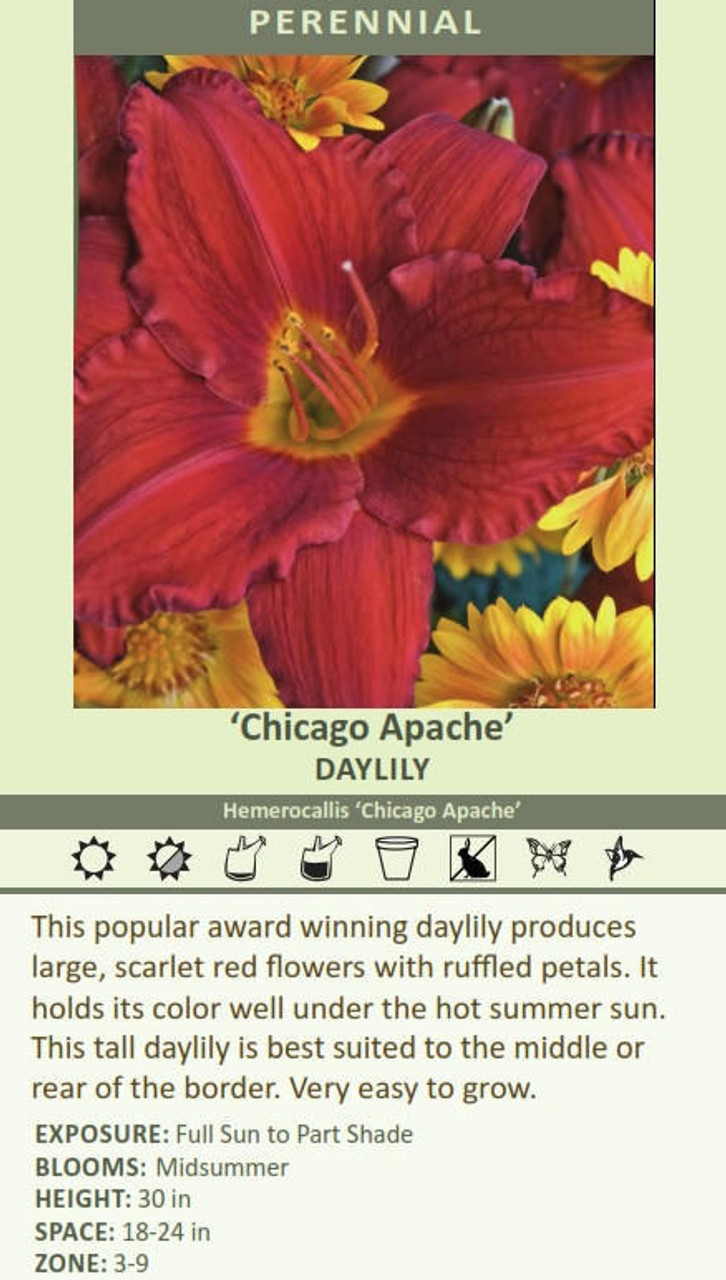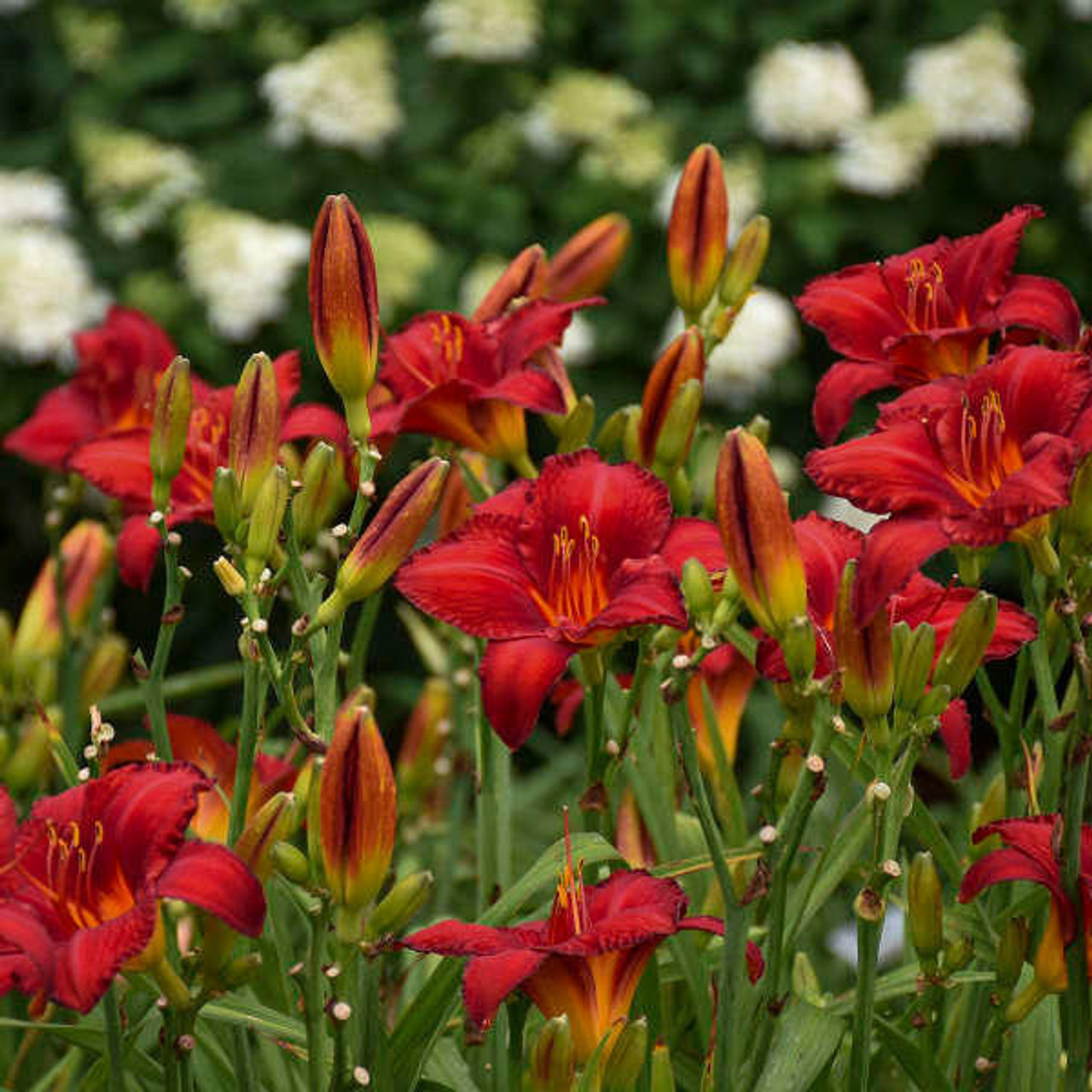Product Description
Hemerocallis 'Chicago Apache' Daylily (MARSH-Klehm, 1981) (4) 1-gallons
- 5", intense scarlet red, recurved tepals with a small sulphur yellow watermark and green throat
- Petals have loosely ruffled edges; sepal edges are slightly crimped.
- Extremely sunfast and more resistant to thrips than most reds
- A very vigorous grower with healthy foliage and sturdy scapes
- Blooms in midsummer
- Tetraploid
- Award: HM '85
Height: 30 Inches
Spread: 18 - 24 inches
Hardiness Zones: 3,4,5,6,7,8,9
Flower Color: Red shades
Full Sun (> 6 hrs. Direct Sun) to Part Shade (4-6 hrs. Direct Sun)
Low to Average Water Needs
Poor to Fertile Soil Quality
Bloomtime: Midsummer Summer
Attracts Butterflies and Hummingbirds
Bee Friendly
Rabbit Resistant
Growth Rate: Medium
Border Plant, Mass Planting, Easy To Grow, Salt Tolerant
Hemerocallis 'Chicago Apache' is a bold and captivating daylily that commands attention with its vibrant, scarlet-red flowers. This classic and beloved perennial features large, 5-inch blooms with gently ruffled, recurved petals and a contrasting yellow throat. The intense color and graceful form make 'Chicago Apache' a standout in any sunny garden. It is a midseason bloomer, providing a dazzling display in mid to late summer. 'Chicago Apache' forms a vigorous clump of arching, sword-like leaves, adding texture and interest even when not in bloom.
Details:
- Mature Size: 27 inches tall, 20 inches wide
- Flower Size: 5 inches across
- Flower Color: Scarlet red with a yellow throat
- Bloom Time: Mid to late summer
- Growth Habit: Clumping
- Sunlight: Full Sun to Partial Shade (Best bloom in full sun)
- Soil: Moist, well-drained
- Hardiness Zones: 3-9
Planting and Care:
- Planting: Choose a location with full sun to partial shade. Daylilies bloom best with at least 6 hours of sunlight per day. Ensure the soil is moist and well-drained. Amend the soil with compost or other organic matter before planting. Dig a hole slightly larger than the root ball and plant at the same depth as the container. Space plants about 20 inches apart.
- Watering: Water regularly, especially during dry periods. Daylilies need consistent moisture to thrive and produce abundant blooms.
- Fertilizing: Apply a balanced fertilizer in early spring as new growth begins. You can also fertilize lightly after the first flush of blooms to encourage reblooming.
- Mulching: Mulch around the plants with shredded bark, compost, or pine needles to retain moisture, suppress weeds, and protect the crown.
- Deadheading: Remove spent flower heads to encourage more blooms and prevent the formation of seed pods, which can divert energy from flower production.
- Division: Divide clumps every 3-5 years, or as needed, to prevent overcrowding and rejuvenate the plant. Division is best done in spring or fall.
Special Considerations:
- 'Chicago Apache' makes a vibrant addition to sunny borders, flower beds, or container plantings.
- Its bold, scarlet-red blooms add a fiery touch to the garden.
- It pairs well with other sun-loving perennials, especially those with contrasting flower colors and textures.
- Daylilies are relatively low-maintenance and are a great choice for both beginner and experienced gardeners.
(4) 1-gallon containers ready to plant, plants may be trimmed for shipping,
Other Details
The most important part of the plant is its root system. Healthy roots are the foundation of a healthy, vibrant plant. The type of plug container used is based on the specific needs of the plants. Perennials offered as bare root traditionally perform better when planted as bare root.Planted in a specialized mix, potted plants have well established root systems. Top growth stage will vary depending on the current life cycle and time of year when shipped. In Winter and early Spring dormant plants may be shipped. Dormant plants may be planted right away, even before the last frost date.
Most bare root varieties are field grown for at least one season, though Hemerocallis and Hosta are grown for two seasons. The bulk of the soil is removed during the harvesting process and the tops of most varieties are trimmed back to the crown. They are graded, packed in shredded aspen or sphagnum moss and stored in freezers until ready to be shipped.
See our Container Sizes and Bare Root Perennials pages for more information.
Plant information and care is provided in the Overview section, Plant Genus Page and general information is provided in the Planting Care & Guides. Additional questions can be asked on each Plant page.
Plant Spacing: Using the maximum mature spread or width of a plant to guide spacing, ensures space to grow to full size. To fill an area sooner, plant them closer together. Just remember, future thinning or transplanting may be needed.
Water: Keep a close eye on newly planted perennials, especially throughout the first growing year. Most early plant loss is due to too much or too little water!
















